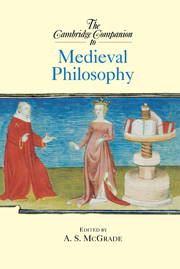Book contents
- Frontmatter
- Introduction
- 1 Medieval philosophy in context
- 2 Two medieval ideas: eternity and hierarchy
- 3 Language and logic
- 4 Philosophy in Islam
- 5 Jewish philosophy
- 6 Metaphysics: God and being
- 7 Creation and nature
- 8 Natures: the problem of universals
- 9 Human nature
- 10 The moral life
- 11 Ultimate goods: happiness, friendship, and bliss
- 12 Political philosophy
- 13 Medieval philosophy in later thought
- 14 Transmission and translation
- Chronology of philosophers and major events
- Biographies of Major Medieval Philosophers
- Bibliography
- Index
2 - Two medieval ideas: eternity and hierarchy
Published online by Cambridge University Press: 28 May 2006
- Frontmatter
- Introduction
- 1 Medieval philosophy in context
- 2 Two medieval ideas: eternity and hierarchy
- 3 Language and logic
- 4 Philosophy in Islam
- 5 Jewish philosophy
- 6 Metaphysics: God and being
- 7 Creation and nature
- 8 Natures: the problem of universals
- 9 Human nature
- 10 The moral life
- 11 Ultimate goods: happiness, friendship, and bliss
- 12 Political philosophy
- 13 Medieval philosophy in later thought
- 14 Transmission and translation
- Chronology of philosophers and major events
- Biographies of Major Medieval Philosophers
- Bibliography
- Index
Summary
Both of the ideas presented in this chapter have roots in late Antique Neoplatonism, but their development is distinctively medieval. Boethius framed a fresh definition of eternity, and if Pseudo-Dionysius the Areopagite did not invent the term hierarchy, he put a stamp on the term that was to carry it through many centuries in many contexts. Eternity and hierarchy can be regarded as something like the temporal and ontological coordinates of medieval thought, with eternity embracing all time and hierarchy vertically grading all beings. The two ideas are at any rate both presuppositions and problems for much of what follows in this volume.
ETERNITY (JOHN MARENBON)
What did medieval thinkers mean when they called God “eternal”? We now give two main senses to “eternity”: perpetuity (“Peternity”) – when something lacks (Pi) a beginning or (Pii) end or (Piii) both; or (“O-eternity”) being altogether outside and unmeasurable by time. Philosophers usually explain O-eternity as “timelessness.” Something is timeless, they say, when it is without either extension or position in time, and so no sentences that contain time references of any sort are true of it. On this account, nothing can be both P-eternal and O-eternal, since a P-eternal thing exists at many times (all times in the case of Piii), whereas an O-eternal thing exists at no time.
- Type
- Chapter
- Information
- The Cambridge Companion to Medieval Philosophy , pp. 51 - 72Publisher: Cambridge University PressPrint publication year: 2003
- 2
- Cited by



